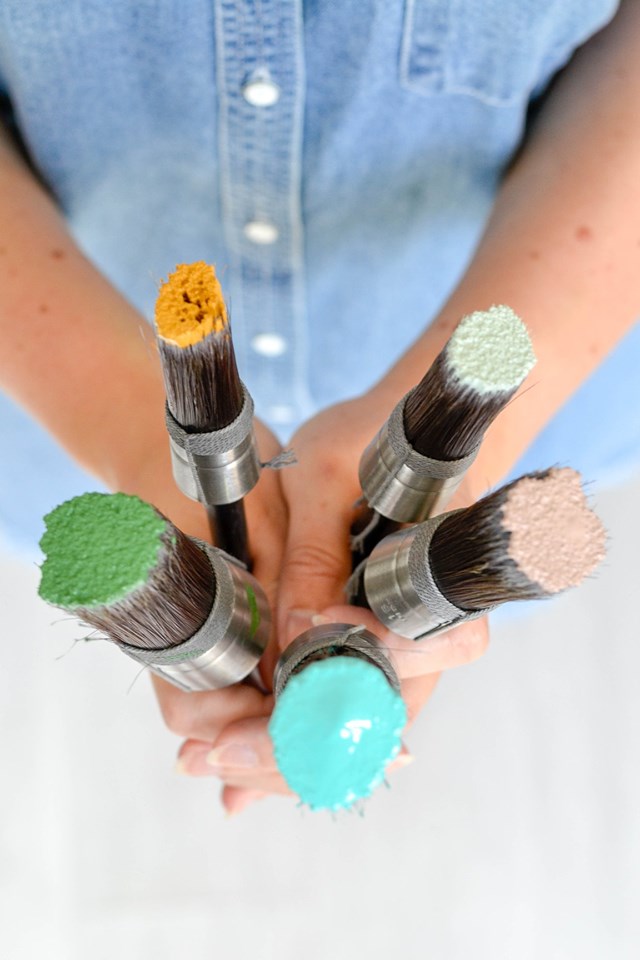Most tradies and experienced painters agree — quality tools make the difference. Many "paint problems" can be solved with a good brush.
Even better? The RIGHT brush.
Why is this the case? Why aren't all brushes created equal? Why do different paints need different brushes?

A brush is a brush, right?
Not always.
Whether you are a newbie DIY-er or an avid furniture upcycler, this guide will clear things up by providing the information to make the right decision when selecting the correct brush for the job!

Our European Friends...Cling On!
Handmade in Holland Cling Ons are the Rolls Royce of paint brushes and the bonus is they work with any water-based paint including Chalk Paint, Milk Paint, Mineral Paint and water-based latex or acrylic paint.
It's the very best of painting worlds where you do not have to remember which brush is for which paint. Cling Ons! have you covered regardless of the paint you're using providing exceptional coverage while minimising brushstrokes — and they self-clean!

Granted, avid painters will benefit from (and take pride in) a collection of brushes for various finishes, but for those starting out and not wanting to invest in multiple brushes, one all-rounder like the Cling On! Oval 35 or Round 18 is the way to go. These brushes are available in Flat, Round, Oval shapes and various sizes including the popular short-handled Shorties and their brand new Pointed series.




Our Other European Friends...Staalmeester
Onto Staalmeester who have been manufacturing brushes for 70+ years and with that experience comes an exceptional range of brushes!. The unique blend of short natural china bristle with longer silky synthetic bristle ensures better paint absorption with a smooth, even application.

Staalmeester bristles have a band of string that is to be kept intact as they give the bristles direction and perfect tension.


In addition to the original blended-bristle brush, Staalmeester introduced an all-synthetic range of brushes that are incredibly silky leaving a near brushstroke-free finish as well as an all natural bristle brush that is perfect for waxing furniture or leaving a heavy textured appearance.
____________________________
Natural Bristle Paint Brushes
Can you use a synthetic polyester or nylon brush with these paints? Absolutely. But what happens is paint slides off the bristles forcing you to repeatedly reload your brush reducing the quality of the finish. In addition, the bristles can be stiff or slick and lead to excessive drag marks and patchiness.

The soft flexibility of natural bristle brushes smoothly apply a thin, even layer of paint minimising streaks and working to distribute paint evenly. This prevents the "lines" you can get with synthetic brushes.


Coverage and finish is massively improved when using these brushes with most clay, chalk and milk-based paints. Inexpensive chip brushes are another option and are typically made from all natural bristles. Cling Ons and Staalmeesters work very well for a smoother finish with these paints.
*Natural bristle brushes tend to shed with the first couple of uses, however, quality brushes stop shedding after the second or third use.
____________________________
Brand-specific Paint Brushes
Ok, so I have my natural bristle paint brush and now I want to use a Mineral Paint.
Wellllllll, not exactly...
These are high-quality acrylic paints and you tend to get poor coverage and a streaky finish when using a natural bristle brush with them. There is something about the satiny-smooth finish and built-in sealer that doesn't work optimally with natural bristle paint brushes. Unless of course you're after a textured, hand-painted look!




We recommend a natural soap to gently clean and condition so you will have your paint and wax brushes for life! In a pinch olive oil or goat soap works but for the absolute best cleaning and conditioning use one designed just for this purpose like Dixie Belle Clean As A Whistle Brush Cleaner to remove build-up and dried paint from brushes leaving them wonderfully clean.
Its all here...for the love...
Sada



Leave a comment